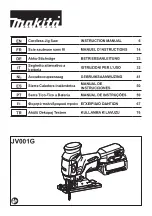
22
22
Blade Selection
Material
Sawblade
<3mm
>5mm
>50mm
>100mm
>150mm
>200mm
<0.12”
>0.2”
>2”
>4”
>6”
>8”
(HSS) 14T
•
(HSS) 6/10T
•
(HSS) 5/8T
•
(HSS) 4/6T
•
•
(HSS) 3/4T
•
(HSS) 2/3T
•
•
(HSS) 1/2T
•
(HCS) 10T
•
(HCS) 8T
•
(HCS) 6T
•
(HCS) 4T
•
(HCS) 2T
•
•
Remarks: HSS-High Speed Steel Sawblade
HCS-High Carbon Steel Sawblade
Note:
•
When cutting standard wall pipe, tubes, channel iron, angle iron, and I beam, a 10 pitch saw
blade of wave-set type or sawblade of (HSS) 6/10T is frequently used for good advantage.
•
Tubes or structure with wall thickness or web thickness of 1/2” or more usually uses an 8 or
6 pitch blade or sawblade of (HSS) 4/6T satisfactorily.
•
When rectangular solid bar is to be sawed, the work should, whenever possible, be loaded
with the thinnest cross section exposed to the blade teeth. The pitch (or number of teeth per
inch of blade) selected must provide engagement of at least 3 teeth in the workpiece. Should
application of this rule not be possible because the thinnest cross section is too thin, the
piece must be loaded with the wider dimension exposed to the saw teeth and a coarser
blade selected from the listing of recommendations for round and square solid bars.
Summary of Contents for BS-916M
Page 3: ...ELECTRICAL COMPONENTS 44 ELECTRICAL SCHEMATIC 46...
Page 15: ...12 12 GETTING TO KNOW YOUR MACHINE A G E D C F B H I J K L N P Q O M S T U V W X R...
Page 37: ...34 34 PARTS DIAGRAM...
Page 38: ...35 35...
Page 48: ...45 45...
Page 49: ...46 46 ELECTRICAL SCHEMATIC...
Page 50: ...47 47 NOTES...
Page 51: ...48 48 NOTES...
















































